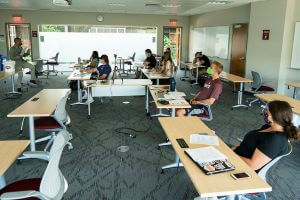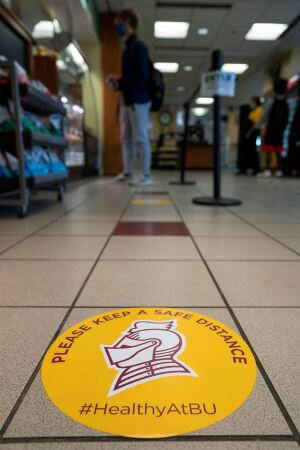In the second full week of classes of the 2020-21 academic year, Bellarmine University students and faculty are settling into “the new normal.” For most, that means attending and teaching classes in a mix of three formats: in-person, online
and a hybrid of the two called HyFlex.
In-person classes are possible when the scheduled classroom can accommodate the physical-distancing
policies required by COVID-19.
Online classes are taught completely online, but each includes synchronous, or “live” elements. HyFlex (for “high flexibility”) classes blend in-person and online experiences. For example, half of the students might attend
in person on Tuesdays, with the other half online, and the two groups then switch on Thursdays. Students may also opt to take everything online.
Of the 1,070 courses offered this semester, 36 percent are HyFlex, 33 percent are online, and 17 percent are completely in person. (The remaining 14 percent are more individualized offerings, such as clinicals.)
“The schedule was designed to permit maximum flexibility for both students and faculty while prioritizing the health and safety of the entire Bellarmine community,” said Dr. Paul Gore, vice president for Academic Affairs and provost. “Overall,
every student will have the opportunity to engage in the high-quality teaching and learning that led them to Bellarmine in the first place.”
“I love my HyFlex classes,” said Trey Grevious, a senior majoring in communications. Three of his five courses are being taught in the hybrid format, with each student meeting once per week in person and once online. His other two classes
are taught completely online.

The HyFlex approach allows proper physical distancing but “still allows me to interact in person with my classmates,” Trey said, “and I appreciate that so much.”
But being in person is also more challenging this semester because students and faculty are required to wear face coverings when they are in public. Dr. Tim Glasscock, director of the Music Program, said he finds himself being even more ebullient than
usual when he’s teaching, because with a mask on, “all they [students] can see is my frantic eyes.”
“I’m also having much more trouble memorizing names because I can’t see what people look like,” he added. “I keep thinking, ‘Blonde hair, grey eyes, or blonde hair, blue eyes—wait, do I even know this student?’”
"As an ‘old dog’ learning new tricks, my ultimate goal is the same as it has always been: to share my love of nature with a new generation of scientists."--Dr. Rob Kingsolver
The university invested about $10,000 to equip every classroom with a webcam and tripod over the summer so that every class could be taught online if circumstances change, said Adam Elias, director of Innovative Learning Systems.
Bellarmine also added Internet bandwidth to ensure smooth video streaming and updated Moodle, the online learning system that allows faculty to share things like lesson plans and assessments, said Chief Information Officer Eric Satterly.
Online interactions are being conducted through Microsoft Teams. Microsoft is continually improving the functionality and security of the platform, Satterly said, which has protected Bellarmine so far from hacking incidents such as those that occurred
in Jefferson County Public Schools when some middle and high school students disrupted virtual classrooms they weren’t assigned to. JCPS is now switching from Google Meets to Microsoft Teams.
In April, Bellarmine installed a new video platform called Kaltura, “which has been critical in all of this to ensure that digital media is easy and shareable while everyone is spread around,” Elias said. The platform costs about $25,000 per
year. “I’ve also provided around $6,000 in equipment directly to faculty to equip them to teach. We’re not saving any money in instructional costs by going online, since everything else in the typical equation is still there.”

Denise Brown-Cornelius, assistant vice president for Business Affairs, estimated that Bellarmine will also spend more than $300,000 this fiscal year on COVID-19-related operational items, including $160,000 in personal protective equipment (PPE) and $18,500
per semester on additional custodial staff (the figure excludes information technology and athletics). The Student Government Association spent approximately $26,000 to enhance outdoor areas, including additional chairs, a tent and umbrellas.
Many professors spent the summer retooling their classes for online and HyFlex delivery. Dr. Kate Bulinski, associate professor of geosciences and interim chair of the Department of Environmental Studies, redesigned her courses as a “flipped classrooms,”
where students engage with lectures online and spend face-to-face time on activities like labs, discussion and demonstrations.
“In order to accommodate students choosing to take the class 100 percent online, or for students who might need to quarantine, I put together lab kits so that everything could be completed at home,” she said. Students coming to class bring
the supplies they need that day so they don’t have to share with others.
Bulinski worked far enough ahead to order the supplies and put together 72 kits, shipping them to students living out of state. “The students seem really excited about getting the kit, even though they’re not that exciting,” Bulinski
said. “They contain a ruler, colored pencils, a kitchen scale, a measuring reel, a roll of adding-machine paper, a full-sized topographic map of Louisville, some handouts, and some other odds and ends.”
Bulinski, who has infant triplets and a 4-year-old, said she is glad to have the classes built out. “I have courses that can run 100 percent online if my childcare falls through or I need to quarantine,” she said. “I think the courses
I put together are really solid, and I will very likely offer online versions in the future since I’ve already put the work in.”
Olivia Atkinson, a sophomore history and political science major who served on one of Bellarmine’s reopening committees, has all three types of classes this semester, though the majority of her professors chose to teach fully online.
“The HyFlex option offers a happy medium between the other two modes, and I appreciate the balance between being able to physically be present in the classroom while also allowing for physical distancing,” she said. “Teams calls can
be a bit exhausting, so it is definitely nice to be able to take a break from that for part of the week.
“Overall, I think the work our contingency teams have done to prepare for this semester has really paid off in that our academics, while not what we are used to, are still robust and engaging.”
Dr. Jon Blandford, associate professor of English and director of the Bellarmine Honors Program, said he’s been pleasantly surprised by his experience with the HyFlex format and its potential for creative instruction.
“Just the other day, I had my students attending class in person and participating virtually collaborate on a writing exercise, all while 6 feet apart—or in the case of the students participating virtually, much further—with the text
appearing as if by magic up on the big screen in the front of the classroom as they were producing it,” he said. “I’m not ready to trade my Ph.D. in 19th-century American literature for one in computer science just yet, but I am
having fun and am thrilled to be able to deliver for our students a Bellarmine-worthy educational experience.”
Dr. Rob Kingsolver, a professor of ecology, has had a similar reaction. “I do miss walking into a classroom of ecology students, but the distance-learning tools we have in 2020 allow even more flexible and individualized communications than I've
experienced throughout most of my teaching career,” he said.
But “as an ‘old dog’ learning new tricks, my ultimate goal is the same as it has always been: to share my love of nature with a new generation of scientists.”